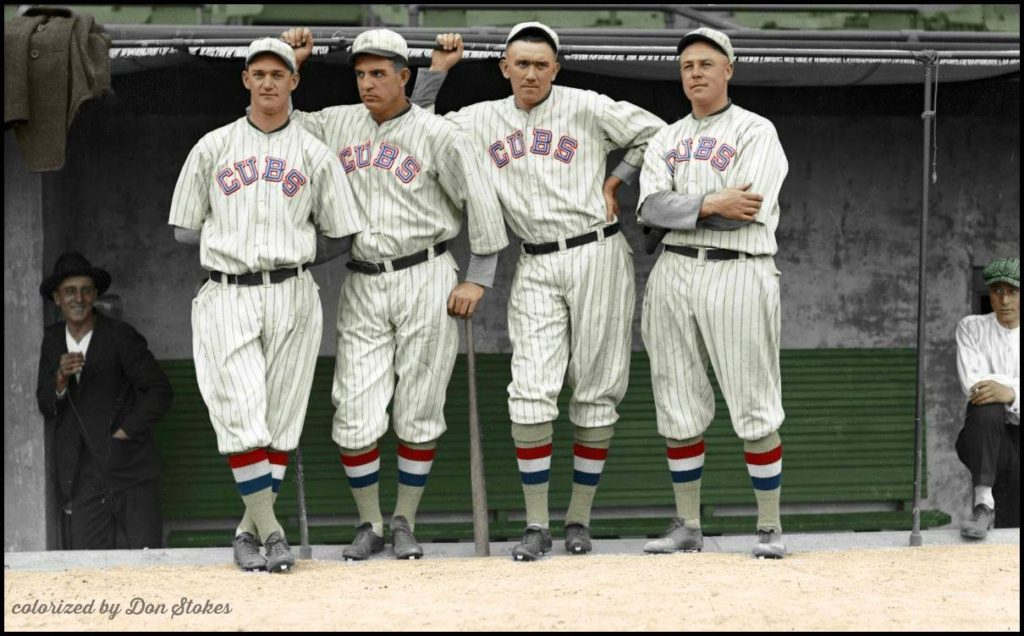Subscribe to Baseball History Comes Alive! to receive new posts automatically
“1918 Cubs and the Dysfunctional 1918 Season” Photo Gallery
Click on any image below to see photos in full size and to start Photo Gallery:
Back Into the Dead Ball Era We Go! The 1918 Season and the Pennant-Winning Cubs!
Here’s one of my favorite Dead Ball Era photos. It’s a photo of the 1918 Cubs starting pitchers beautifully colorized by our resident baseball artist, Don Stokes. L-R: Lefty Tyler, Jim “Hippo” Vaughn, “Shufflin’ Phil” Douglas, Claude Hendrix. As always, Don does extensive research before doing a colorization and is meticulous in his detail. This is one of his best. There’s even a couple vintage-1918 photo bombs!
With World War I lurking in the background, it’s not surprising the 1918 was one of the most dysfunctional years in baseball history. Due to the war effort, the government ordered the 1918 season halted on Labor Day. In the shortened season, the Cubs won the National League pennant (84-45); while the Red Sox (75-51) won the American League pennant and the World Series, four games to two.
World War I had formally been declared in April of 1917, but players didn’t begin to muster out until General Crowder’s “work or fight” order in June, 1918. With war-depleted rosters, the season was anything but a competition between the best teams, and fan interest waned.
Probably the most significant event of the 1918 season – one which would have lasting effects on the game – was the conversion of a budding star named George Herman Ruth to the outfield between pitching starts. While going 13-7 with a 2.22 ERA on the mound, he hit .300 with 11 triples, 11 home runs (tied for the league lead), and 66 RBI (third-best in the league) in only 317 at-bats. In the World Series, Ruth went 2-0 with a 1.06 ERA, while increasing his scoreless streak to a record twenty-nine consecutive innings.
If things weren’t bad enough with the specter of war hanging in the air, baseball was also in an era in which gambling infested the game much as steroids did in a later generation. Severe war-related financial shortcomings made the situation prime for gamblers offering the allure of “payoffs” to the underpaid players for throwing games. There were rumors abounding that some players agreed to throw World Series games. Added to the mix was that the Cubs had a number of players with shady pasts: Lee Magee, Claude Hendrix, Charlie Hollocher, Max Flack, and Phil Douglass.
When the players found out they would be receiving considerably less money than promised (the winners would receive $1,200 per man and the losers $800), they threatened to strike before Game 5. Only an appeal to patriotism by Boston’s Mayor Fitzgerald ended the threat.
Gamblers and players mingled freely, and gamblers openly conducted their business in major league parks. Should a player desire to make some money illicitly, there were plenty of opportunities to do so. The situation was ripe for “fixing.” Unfortunately, it came to a head the following year in the 1919 World Series, tainted by the Black Sox scandal. All in all, 1918 was a year most baseball fans would just as soon forget.
Gary Livacari
Photo Credits: Featured photo colorized by Don Stokes; Others from the book The Original Curse, by Sean Deveney, and from Google search.
Information: Excerpts edited from 1918 baseball Wikipedia page.
We are a participant in the Amazon Services LLC Associates Program, an affiliate advertising program designed to provide a means for us to earn fees by linking to Amazon.com and affiliated sites. Click here to view Amazon’s privacy policy

